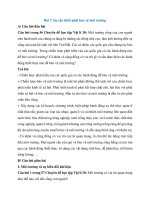x0022 top 10 things you should know about sql server performance tunin morebook vn 9313
Bạn đang xem bản rút gọn của tài liệu. Xem và tải ngay bản đầy đủ của tài liệu tại đây (166.23 KB, 7 trang )
Top 10 Things You Should Know About
Optimizing SQL Server Performance
written by
Patrick O'Keeffe,
Senior Software Architect,
Quest Software, Inc.
© Copyright Quest® Software, Inc. 2007. All rights reserved.
This guide contains proprietary information, which is protected by copyright. The
software described in this guide is furnished under a software license or
nondisclosure agreement. This software may be used or copied only in accordance
with the terms of the applicable agreement. No part of this guide may be
reproduced or transmitted in any form or by any means, electronic or mechanical,
including photocopying and recording for any purpose other than the purchaser's
personal use without the written permission of Quest Software, Inc.
WARRANTY
The information contained in this document is subject to change without notice.
Quest Software makes no warranty of any kind with respect to this information.
QUEST SOFTWARE SPECIFICALLY DISCLAIMS THE IMPLIED WARRANTY OF THE
MERCHANTABILITY AND FITNESS FOR A PARTICULAR PURPOSE. Quest Software
shall not be liable for any direct, indirect, incidental, consequential, or other
damage alleged in connection with the furnishing or use of this information.
TRADEMARKS
All trademarks and registered trademarks used in this guide are property of their
respective owners.
World Headquarters
5 Polaris Way
Aliso Viejo, CA 92656
www.quest.com
e-mail:
Please refer to our Web site for regional and international office information.
Updated—September 17, 2007
WPD_Top10thingsAboutOptimizingSSPerf_091707_AG
CONTENTS
INTRODUCTION ..........................................................................................1
WHAT PROBLEM ARE WE TRYING TO SOLVE?..............................................2
10.
BASELINING AND BENCHMARKING ARE A MEANS TO AN END .........3
WHAT ARE BASELINING AND BENCHMARKING? ....................................................... 3
WHAT BASELINING CAN’T DO............................................................................ 3
9.
PERFORMANCE COUNTERS – HOW TO CUT TO THE CHASE ..................5
OPERATIONAL MONITORING .............................................................................. 5
BOTTLENECK MONITORING ............................................................................... 6
8.
WHY CHANGING SP_CONFIGURE SETTINGS PROBABLY WON’T HELP.7
7.
I HAVE A BOTTLENECK – WHAT DO I DO NOW? ..................................8
6.
SQL PROFILER IS YOUR FRIEND .........................................................9
START A TRACE ............................................................................................ 9
5.
ZEN AND THE ART OF NEGOTIATING WITH YOUR SAN
ADMINISTRATOR ............................................................................. 13
4.
THE HORROR OF CURSORS (AND OTHER BAD T-SQL) ....................... 15
3.
PLAN REUSE – RECYCLING FOR SQL ................................................. 17
2.
THE MYSTERY OF THE BUFFER CACHE............................................... 19
1.
THE TAO OF INDEXES ....................................................................... 21
SYS.DM_DB_INDEX_OPERATIONAL_STATS ...........................................................
SYS.DM_DB_INDEX_USAGE_STATS ...................................................................
21
22
AND AN EXTRA ONE FOR GOOD MEASURE. LEARN XPATH ......................... 23
CONCLUSION ............................................................................................ 25
ABOUT THE AUTHOR ................................................................................. 26
ABOUT QUEST SOFTWARE, INC. ................................................................ 27
CONTACTING QUEST SOFTWARE ....................................................................... 27
CONTACTING QUEST SUPPORT ......................................................................... 27
T
NOTES ....................................................................................................... 28
i
White Paper
INTRODUCTION
Performance optimization on SQL Server is difficult. A vast array of information
exists on how to address performance problems in general. However, there is not
much information on the specifics and even less information on how to apply that
specific knowledge to your own environment.
In this whitepaper, I discuss the 10 things that I think you should know about SQL
Server performance. Each item is a nugget of practical knowledge that can be
immediately applied to your environment.
1
Top 10 Things You Should Know About Optimizing SQL Server Performance
WHAT PROBLEM ARE WE TRYING TO SOLVE?
The problem is a simple one: How do you get the most value from your SQL Server
deployments? Faced with this problem, many of us ask: Am I getting the best
efficiency? Will my application scale?
A scalable system is one in which the demands on the database server increase in a
predictable and reasonable manner. For instance, doubling the transaction rate
might cause a doubling in demand on the database server, but a quadrupling of
demand could well result in the system failing to cope.
Increasing the efficiency of database servers frees up system resources for other
tasks, such as business reports or ad-hoc queries.
To get the most out of an organization’s hardware investment, you need to ensure
that the SQL or application workload running on the database servers is executing
as fast and as efficiently as possible.
There are a number of drivers for performance optimization, including:
•
Tuning to meet service level agreement (SLA) targets
•
Tuning to improve efficiency, thereby freeing up resources for other
purposes
•
Tuning to ensure scalability, thereby helping to maintain SLAs into the
future
Performance optimization is an ongoing process. For instance, when you tune for
SLA targets, you can be ‘finished’; however, if you are tuning to improve efficiency
or to ensure scalability, your work is never really finished. This tuning should be
continued until the performance is ‘good enough’. In the future, when the
performance of the application is no longer ‘good enough’, this tuning should be
performed again.
‘Good enough’ is usually defined by business imperatives, such as SLAs or system
throughput requirements. Beyond these requirements, you should be motivated to
maximize the scalability and efficiency of all database servers—even if business
requirements are currently being met.
As stated in the introduction, performance optimization on SQL Server is
challenging. There is a wealth of generalized information on various data points
(counters, DMVs) available, but there is very little information on what to do with
this data and how to interpret it. This paper describes 10 things that will be useful
in the trenches, allowing you to turn some of the data into information.
2
White Paper
ABOUT QUEST SOFTWARE, INC.
Quest Software, Inc. delivers innovative products that help organizations get more
performance and productivity from their applications, databases and Windows
infrastructure. Through a deep expertise in IT operations and a continued focus on
what works best, Quest helps more than 50,000 customers worldwide meet higher
expectations for enterprise IT. Quest Software can be found in offices around the
globe and at www.quest.com.
Contacting Quest Software
Phone:
949.754.8000 (United States and Canada)
Email:
Mail:
Quest Software, Inc.
World Headquarters
5 Polaris Way
Aliso Viejo, CA 92656
USA
Web site
www.quest.com
Please refer to our Web site for regional and international office information.
Contacting Quest Support
Quest Support is available to customers who have a trial version of a Quest product
or who have purchased a commercial version and have a valid maintenance
contract. Quest Support provides around the clock coverage with SupportLink, our
web self-service. Visit SupportLink at
From SupportLink, you can do the following:
•
Quickly find thousands of solutions (Knowledgebase articles/documents).
•
Download patches and upgrades.
•
Seek help from a Support engineer.
•
Log and update your case, and check its status.
View the Global Support Guide for a detailed explanation of support programs,
online services, contact information, and policy and procedures. The guide is
available at: Support Guide.pdf
27
Top 10 Things You Should Know About Optimizing SQL Server Performance
NOTES
1
When using Windows disk counters, it is necessary to adjust for RAID
configurations. You can do this using the following formulas:
Raid 0
value = (reads + writes) / number of disks
Raid 1
value = [reads + (2 * writes)] / 2
Raid 5
value = [reads + (4 * writes)] / number of disks
Raid 10
value = [reads + (2 * writes)] / number of disks
28







